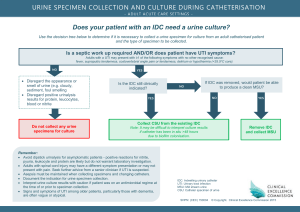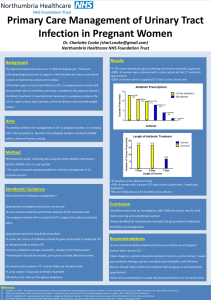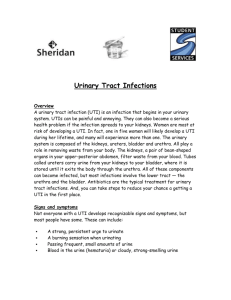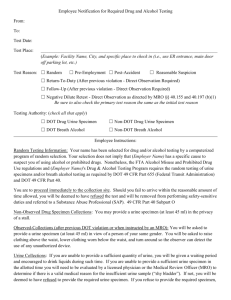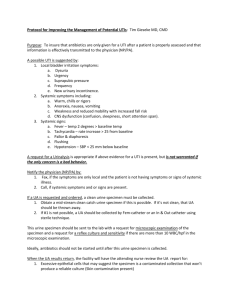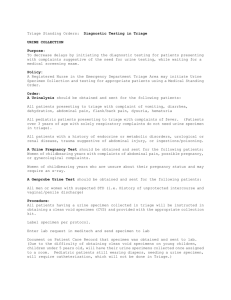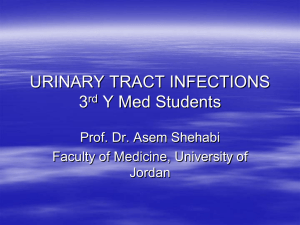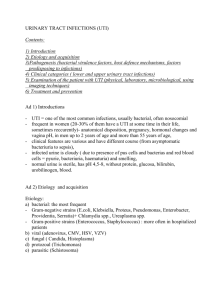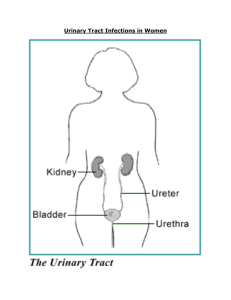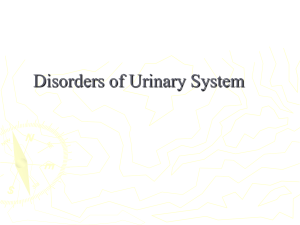Urinary Tract Infection
advertisement
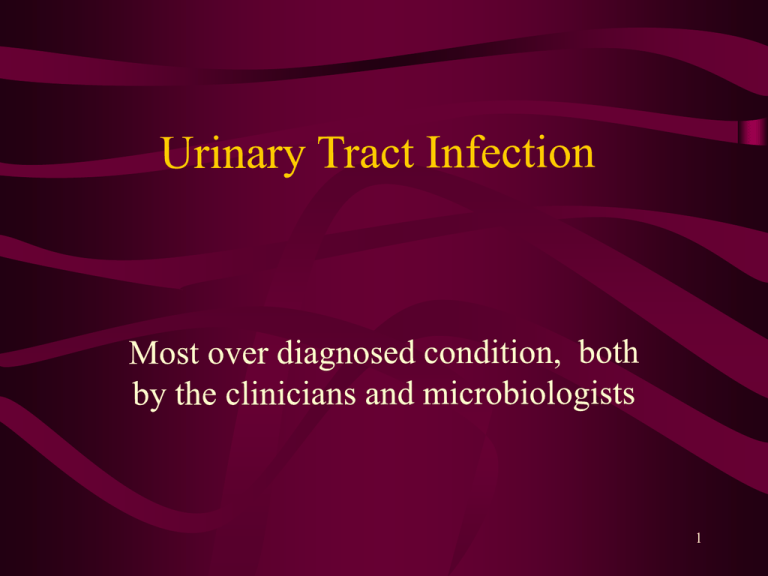
1 Definition • Lodgment and multiplication of bacteria in the urinary tract from pelvis to bladder • Specific infections like MTB excluded • Renal and urethral infections excluded 2 Urinary Tract Only lower part of urethra has a resident bacterial flora Rest of the urinary tract is normally sterile Flushing effect of urine flow Local phagocytic activity Mucosal IgA and secretions from prostatic and urethral glands 3 Definitions Bacteriuria Presence of bacteria in the urine Pyuria Presence of WBCs in the urine Cystitis UTI associated with superficial mucosa o f bladder Pyelonephritis UTI of renal parenchyma and or collection system Uncomplicated UTI Infection involving structurally and functionally normal urinary tract (simple UTI) Complicated UTI Infection involving structurally and functionally abnormal urinary tract Urethritis Infection of the urethra 4 Concept of Significant Bacteriuria • Up to 104/ml considered normal i.e. Insignificant • 105/ml and above considered to be Significant • Concept valid only for voided specimen of urine • Exceptions - slow growing organisms, patient on antibiotic therapy, diuretic therapy 5 Predisposing factors for UTI Shortness of female urethra Sexual intercourse (honeymoon cystitis) Pregnancy & Contraceptive devices Prostatic hypertrophy Neurogenic bladder Abnormal kidney & bladder or stones Catheterization or surgical instrumentation 6 Clinical manifestations Urgency Frequency Dysuria Pain & tenderness - above the symphysis pubis (lower), loin (upper) Fever Bed wettings in children 7 Importance of Urine RE • • • • • Presence of proteins Presence of pus cells Presence of bacteria Correlation with growth obtained Suspicion of anaerobic bacterial infection 8 Bacteria Commonly Encountered in UTI • • • • • • • E. Coli Proteus Klebsiella Pseudomonas Citrobacter Staph aureus Anaerobes particularly bacteroides • Enterococcus ie Group D streptococci. 9 Pathogenicity By ascending route following colonization or periurethral area by enteric organisms Rarely hematogenous Entry of microorganisms Some strains of E coli (uropathogens) possess pili interacting with galactose containing receptor sites on epithelial cell surfaces Proteus sp. possess urease, which raises the pH and cause precipitation of phosphate crystals leading to stone formations Ability to adhere urinary epithelial cells 10 Collection of Specimens • • • • • • • Clean catch mid-stream specimen of urine Early morning sample preferred Catheter specimen Suprapubic aspiration Differential specimen from two ureters Instructions to the patients Early transport to the lab essential 11 Instruction for collection of mid stream urine Sterile specimen container Female patients Spread labia, using plain soap or antiseptic wipe front to back, dry with tissues Begin passing urine Stop flow in midstream Pass several ml into pen container without touching rim Stop flow before it ends Recap container Pass remaining urine into lavatory Send specimen to laboratory immediately (refrigerate if prolonged transport time) Male patients Retract prepuce, using plain soap or antiseptic clean glans. Dry with tissues. 12 Presumptive Screening Tests • • • • Griess nitrite test Catalase test Triphenyltetrazolium chloride (TTC) test Microscopic demonstration of bacteria in smear stained by gram’s method • Glucose test method • Dip slide culture method 13 Processing of Specimen • Uncentrifuged specimen inoculated on CLED medium – Cystein, lactose, electrolyte-deficiency medium • Centrifuged specimen used for microscopic exam – Unstained – Gram stained 14 Lab Diagnosis of UTI Specimens Urine Mid stream urine (MSU) Catheter specimen urine (CSU) Supra pubic aspiration (SPA) Urine transport device (boric acid or refrigerate) Microscopy wet mount Pus cells / hpf Bacteria / crystals/ casts Gram stain GNB/GPC Urine Culture Kass semi-qauntative method (1 bacterium / field is significant) Standard loop technique To know significant bacteriruria 15 Antibiotic Sensitivity Testing • High potency disks used • Antibiotics normally active in urine selected • Antibiotics found in higher concentration in urine preferred • Primary sensitivity test frequently used 16 How to suspect anaerobic UTI? • Extremely foul smelling urine • Failure to respond to usually useful antibiotics against aerobes • Failure to grow bacteria seen in Gram stain prepared from centrifuged specimen 17
